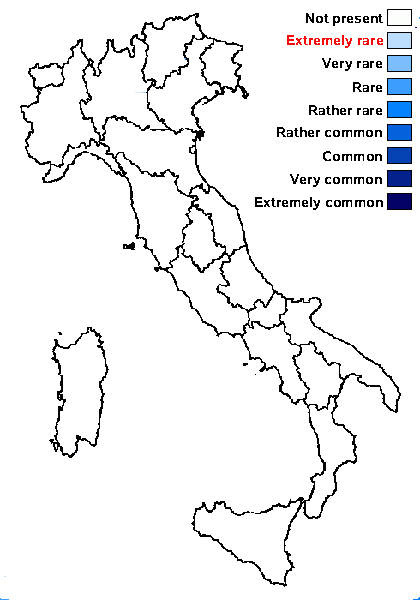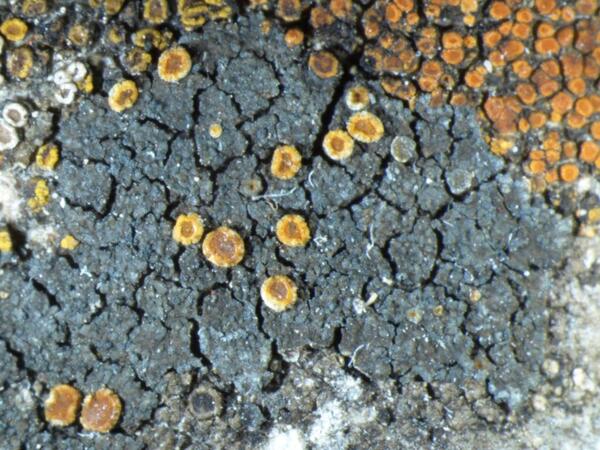Kuettlingeria emilii (Vondrák, Khodos., Cl. Roux & V. Wirth) I.V. Frolov, Vondrák & Arup
in Frolov & al., J. Syst. Evol. 59, 3: 468, 2020. Basionym: Caloplaca emilii Vondrák, Khodos., Cl. Roux & V. Wirth - in Vondrák & al., Lichenologist, 45, 6: 709, 2013
Synonyms:
Distribution:
Description: Thallus crustose, episubstratic, areolate, brown-grey or pale to dark grey, epruinose, forming up to several cm wide, irregular patches, often starting the life-cycle on other crustose lichens. Areoles contiguous, angular to rounded, flat to slightly convex, (0.3-)0.6-1.1(-2.5) mm wide, 100-500 µm thick, blastidiate. Blastidia globose, dark grey, arising at the margins, rarely also on the upper surface of the areoles, (20-)53-95(-210) µm in diam. Cortex developed in patches, up to 30 mm thick, not gelatinous, often with an up to 10 µm thick epinecral layer; medulla well-developed only in thick thalli, loosely prosoplectenchymatous, non-amyloid. Apothecia zeorine, rather rare, (0.3-)0.5-0.9(-1.4) mm across, with an orange brown disc (more orange in young apothecia), a yellow proper margin, and a grey thalline margin. Exciple 70-110 µm wide, formed of a 30-60 µm wide proper exciple and a 10-70 µm wide, mostly ecorticate thalline exciple; upper part of proper exciple of thin-walled spherical cells, lower part of a palisade prosoplectenchyma; epithecium yellow-brown, K+ purple-red, C+ purple; hymenium colourless, 70-110 µm high, I+ blue; paraphyses simple or sparingly branched and anastomosing, 2-2.5 µm thick in lower part, the apical cells 3-4(–5) µm wide; hypothecium colourless, 100-300 µm high, with a subhypothecial algal layer. Asci 8-spored, cylindrical-clavate, functionally unitunicate, apically thickened with a broad internal beak, the inner part of apex and external cap I+ blue, Teloschistes-type. Ascospores 2-celled, polarilocular, hyaline, ellipsoid, (8.0-)12-13.5(-15) x (5-)7-8(-9.5) µm, the equatorial thickening (“septum”) (4-)5-6(-7.5) µm. Pycnidia rare, dark grey in apical parts, the pigmented parts of the wall K+ faintly violet. Conidia ellipsoid to tear-shaped, 2-2.5 x c. 1.5 µm. Photobiont chlorococcoid. Spot tests: thallus K-, C-, KC-, P- (but uppermost layer and pycnidial wall K+ violet N+ red in section); apothecia K+ purple-red, C+ purple. Chemistry: thallus and especially tips of pycnidia with the Sedifolia-grey pigment; apothecia with fragilin (major) and 7-Cl-emodin.
Note: on horizontal to slightly inclined rock faces of limestone outcrops in habitats with steppe-like conditions; widespread in the Mediterranean region, with several records from the Western Alps (outside Italy); to be looked for in Italy.
Growth form: Crustose
Substrata: rocks
Photobiont: green algae other than Trentepohlia
Reproductive strategy: mainly asexual, by soredia, or soredia-like structures (e.g. blastidia)
paras crustose lichens when young
Commonnes-rarity: (info)
Alpine belt: absent
Subalpine belt: absent
Oromediterranean belt: absent
Montane belt: absent
Submediterranean belt: extremely rare
Padanian area: absent
Humid submediterranean belt: extremely rare
Humid mediterranean belt: extremely rare
Dry mediterranean belt: extremely rare

Predictive model
Growth form: Crustose
Substrata: rocks
Photobiont: green algae other than Trentepohlia
Reproductive strategy: mainly asexual, by soredia, or soredia-like structures (e.g. blastidia)
paras crustose lichens when young
Commonnes-rarity: (info)
Alpine belt: absent
Subalpine belt: absent
Oromediterranean belt: absent
Montane belt: absent
Submediterranean belt: extremely rare
Padanian area: absent
Humid submediterranean belt: extremely rare
Humid mediterranean belt: extremely rare
Dry mediterranean belt: extremely rare

Predictive model
 Index Fungorum
Index Fungorum
 GBIF
GBIF



